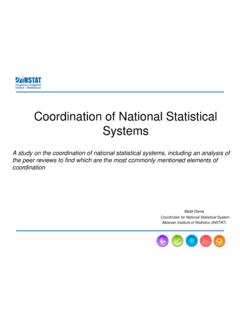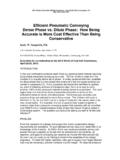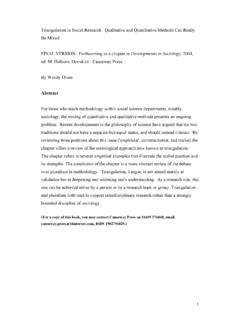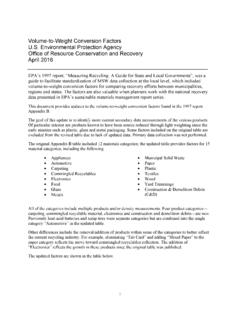Transcription of Poverty in Sub-Saharan Africa: The Situation in the OIC ...
1 Poverty in Sub-Saharan africa : The Situation in the OIC Member Countries A Preliminary Report Statistical, Economic and Social Research and Training Centre for Islamic Countries (SESRTCIC). Organization of the Islamic Conference STATISTICAL ECONOMIC AND SOCIAL RESEARCH. AND TRAINING CENTRE FOR ISLAMIC COUNTRIES. Attar Sokak No. 4, , 06700, Ankara, Turkey Tel: (90-312) 468 61 72-76 Fax: (90-312) 468 57 26. Poverty in Sub- Sub-Saharan africa : The Situation Situation in the OIC Member Countries A Preliminary Report February 2007. Statistical, Economic and Social Research and Training Centre for Islamic Countries (SESRTCIC).
2 STATISTICAL ECONOMIC AND SOCIAL RESEARCH. AND TRAINING CENTRE FOR ISLAMIC COUNTRIES. Attar Sokak No. 4, , 06700, Ankara, Turkey Tel: (90-312) 468 61 72-76 Fax: (90-312) 468 57 26. Foreword Sub-Saharan africa (SSA) is the only region in the world where Poverty , in terms of proportion of the poor, has been rising over time and where the poor are relatively worse off than their counterparts in other parts of the world. With extremely low per capita GDP and savings rates, most countries of the region are in dire need of substantial public investment through external assistance to reverse the current Poverty trends.
3 The report analyzes the incidence of Poverty in Sub-Saharan africa with a special focus on the OIC member countries in the region. The distribution of both the population and land area of the member countries in the region is extremely diverse. The five land-locked OIC members, together with Sudan and Nigeria, account for over 70 per cent of the total population and land area of the Sub-Saharan OIC. members. Furthermore, the comparative analysis of Poverty indicators shows that most of those land-locked economies have also registered appalling records of Poverty indicators.
4 Given their size and population, it is recommended that those countries be granted additional importance in the OIC Poverty alleviation efforts. A survey-based study to determine the special needs of those economies has become a high priority for the success of those efforts. The report also demonstrates a strong link between Poverty and rural population. The countries with a higher proportion of rural population experience a higher incidence of Poverty . It also shows that higher growth in agricultural value-added and productivity are of prime importance in alleviating Poverty .
5 Growth in real GDP per se does not seem to reduce Poverty incidence, considering the high income disparities and strong rural-urban divide in the region. The average agricultural productivity, in terms of cereal output per hectare, in SSA is far below the averages achieved in other regions of the world. Some OIC member countries have recorded better yield per hectare than the regional average. In this connection, the report strongly recommends conducting a research to identify the determinants of productivity differential among the member countries. The findings of such a research would serve to introduce coherent short and long-term policies for increasing the productivity performance of those countries, including the improvement of land fertility and the development of an adequate infrastructure to improve market access.
6 The incidence of communicable diseases such as malaria and tuberculosis is also very high in many OIC member countries in the region. The programme to combat malaria is already in place with the help of the UNICEF and other international agencies. It has been shown that mosquito nets treated with insecticide are very effective in protecting children from the disease. An efficient distribution arrangement of these nets with financial support is a top priority to reduce mortality rates. This preliminary report will be complemented with a series of publications by the SESRTCIC on the same subject.
7 Together, they will constitute a significant contribution in attaining the targets of Poverty alleviation in the African OIC member countries set by the OIC Ten-Year Programme of Action, which was adopted by the 3rd Extraordinary Session of the Islamic Conference Summit in Makkah Al-Mukarramah on 7-8 December 2005. Dr. Sava Alpay Director General Contents 1. 6. Poverty in Sub-Saharan africa : An Overall Assessment .. 6. Dimensions of Poverty in Sub-Saharan 10. 2. Sub-Saharan africa : Review of the OIC Member States .. 14. Population, Land Area and Rural-Urban Divide .. 14.
8 Trends in GDP Growth Rates .. 15. Other Macro-Economic Indicators .. 17. 3. Poverty Indicators and 20. Aggregated Poverty Indicators .. 20. Disaggregated Poverty Indicators .. 21. Poverty Comparisons of the OIC Members in Sub-Saharan africa .. 22. Empirical Analysis of Poverty Indicators .. 24. 4. Policy Implications .. 27. Land-Locked Economies, Rural Population and Agricultural 27. Lack of Access to Basic Social Services .. 29. Education .. 30. Incidence of Malaria .. 31. Poor 31. 5. Concluding 33. References .. 35. Appendix .. 37. Maps Incidence of Endemic Malaria and Infant 13.
9 Figures 1$ a Day Poverty Headcount, by Region, 1980-2003 (% of Population).. 7. Frequency Distribution of Headcount Indices in SSA (2001).. 8. Improvement in the Access to Improved Water Source and Sanitation at Regional 9. Relative Transport Costs in a Typical Sub-Saharan 11. Distribution of Land Area and Population .. 14. Gross Domestic Savings as a Percentage of GDP (2004).. 18. External Debt GDP Ratio (2004) .. 18. GDP Growth Rates Against Export GDP 19. Relationship between HPI and Rural Population .. 21. Boxes Poverty 23. Regression 25. Tables Poverty Gap Index, by Region, 1990-2001 (%).
10 7. Agriculture Risk, Transport Risk and Malaria Risk by 10. Technological Diffusion and Agricultural Productivity .. 12. Classification of OIC Member States in 15. Growth Rates of GDP and GDP/Capita for the Four 16. Poverty and Human Development: Aggregated 21. Rural Population .. 28. Agricultural Productivity and Fertilizer 29. Gross Enrollment 30. Malaria 31. Performances of the OIC Member States in Sub-Saharan 34. Introduction 1. In the year 2000, at the Millennium Summit, the world community agreed on a common platform and agenda to work in harmony in the efforts to alleviate extreme Poverty in the world.











![001 4-OL [] - 電成興業株式会社](/cache/preview/5/3/1/6/7/c/5/d/thumb-53167c5d6410af75e6d38a32aa957fff.jpg)
